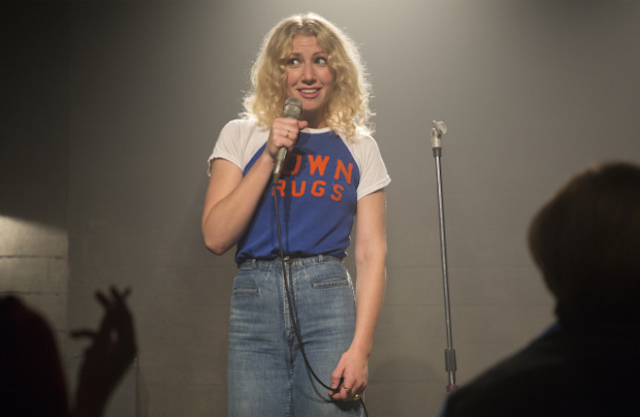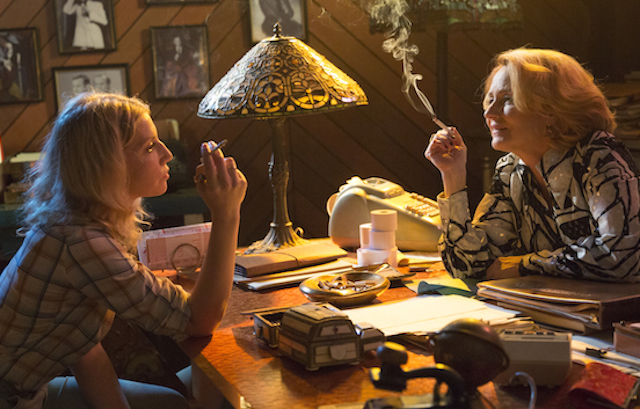CHICAGO – Patrick McDonald of HollywoodChicago.com appears on “The Morning Mess” with Dan Baker on WBGR-FM (Monroe, Wisconsin) on March 21st, 2024, reviewing the new streaming series “Manhunt” – based on the bestseller by James L. Swanson – currently streaming on Apple TV+.
Interview, Audio: Cindy Caponera, TV Writer for ‘I’m Dying Up Here’
- 1970s
- Al Madrigal
- Ari Graynor
- Cindy Caponera
- David Flebotte
- Erik Griffith
- Girls Are Funny Too
- HollywoodChicago.com Content
- Interview
- I’m Dying Up Here
- Jake Lacy
- Jim Carrey
- Los Angeles
- Melissa Leo
- Mitzi Shore
- Patrick McDonald
- RJ Cyler
- Showtime Network
- Stand Up Comedy
- The Comedy Store
- The Second City
- Twin Peaks
- Theater, TV, DVD & Blu-Ray
CHICAGO – One of the great new premium channel TV series, which piggybacked on the “Twin Peaks” return on the Showtime Network, is “I’m Dying Up Here.” Set in the 1970s, it tells the stories of fictional stand up comedians in Los Angeles, and one of the Consulting Producers and series writers is Cindy Caponera.

Ari Graynor as Cassie in ‘I’m Dying Up Here’
Photo credit: Showtime Network
Caponera wrote the latest episode, “Girls Are Funny, Too,” which focused on Cassie (Ari Graynor), as she tries to break new ground in an era where women in comedy had even more obstacles in a man’s show business world. The episode was loose, poignant and funny, and highlighted the excellent cast, which includes Oscar winner Melissa Leo as Goldie, the owner of the club that the stand up comics perform in. Add in Jake Lacy, Al Madrigal, Andrew Santino, Erik Griffin and RJ Cyler, and the world of the comedy in the 1970s is magnificently represented. – the series even places real people like Johnny Carson and Richard Pryor in the mix. “I’m Dying Up Here” was created by David Flebotte and Executive Producer Jim Carrey.
Cindy Caponera was born on the Southside of Chicago in the Back of the Yards neighborhood. She honed her comic skills with two stints in at The Second City comedy club on Wells Street, and began her television writing career with the early Comedy Central series, “Exit 57.” She landed a writing gig on “Saturday Night Live” in 1995, and after three seasons on that show has worked as a freelance TV writer ever since. Her credits includes “Norm,” “My Boys,” “Sherri,” “Ground Floor,” plus Showtime’s “Shameless” and “Nurse Jackie.” In 2014, she published her collection of essays, “I Triggered Her Bully” – named a Kindle Top-Rated Humor Book – and it’s available both in online and print versions. She talks with HollywoodChicago.com for a third time, about her involvement with “I’m Dying Up Here,” both in an interview transcript and audio.
HollywoodChicago.com: The episode you just wrote, ‘Girls Are Funny, Too’ almost seems personal. What was the cathartic effect of writing something that profound about the situation with ‘funny girls’ in the 1970s?
Cindy Caponera: Well, for example, when Cassie [the woman comic portrayed by Ari Graynor] is assaulted in the parking lot in the episode, that was the extension of the oppression felt in that situation. I really identify with Cassie, coming up in a comedy world where you’re struggling to be really funny, yet still be feminine and live your truth… and that world is primarily men. I came up in that type of world a decade later, not in stand-up, but improv comedy. At The Second City back then, if there were two women in an improv group, it meant that there would be four or five guys as ‘the balance.’ Even in TV writing today, my agent will tell me that a show has their ‘woman writer,’ and often I’ve been that one woman in the room.

Cassie and Goldie (Melissa Leo) in ‘I’m Dying Up Here’
Photo credit: Showtime Network
HollywoodChicago.com: How do you connect with the character of Cassie directly?
Caponera: There was a scene in the pilot where she goes in and essentially blackmails Goldie. And I thought, ‘geez, that character has balls.’ She’s always asking for what she needs, and she still gets the backlash like the assault. She’s complicated, ambitious and confident, and in that era she was really doing something different, much different than anything her girlfriends were doing. I was doing the same thing in the 1980s when I was learning improv comedy, not staying in the neighborhood and marrying someone from the gas company or a fireman. It was really difficult.
There is something about ‘having to have to do it.’ I couldn’t not do it. Yes, it is a roll of the dice, but there is a part of me that thought if I don’t do it, what else am I going to do? Am I going to work at City Hall or get a civil servant job? What else would I do?
HollywoodChicago.com: Much like the groundbreaking “Mad Men,” “I’m Dying..” looks at the events of the 1970s decade through the characters in a particular workplace. What list of characteristics did the show want to emphasize regarding the climate of emotions in the era through those diverse characters?
Caponera: What I would say would be the realism of it. Like myself, Dave Flebotte [series creator] is about finding the realism as a writer. Everything about the show – I haven’t seen openings credits that beautiful, for example, in a long time – the attractiveness and the darkness of the characters, the way the show is lit and shot… it’s all done to find the realistic elements of the time and place. We set the first season in 1973, right on the precipice when everything exploded [Nixon resigns] in 1974. But now that I’ve seen the show put together, after so many lines of dialogue and ideas in the writers room, I’m blown away.
HollywoodChicago.com: How did you make decisions for the characters, in how their careers would progress?
 Cindy Caponera of ‘I’m Dying Up Here’ Photo credit: Cindy Caponera |
Caponera: We purposefully tracked all the different ways a stand-up career could go, for all these different characters. RJ Cyler, who portrays the young African American comic Adam, he has a path like Richard Pryor. He tells the older black comic named Ralph [Erik Griffin] – who also writes for ‘The Sonny and Cher Show’ – that he could never do things like that in his career, and it affects and blows up how Ralph views his situation, just because that young kid wants his own voice.
There is also Sully [Stephen Guarino], who has a wife, kid and day job. Is he going to be able to balance all that? We talked about it at length, I saw many people in my career who I met, who went different ways in life and suddenly wasn’t there doing comedy any more. So all these paths were considered.
HollywoodChicago.com: The series has a basis in a source novel and Goldie is loosely based on famous comedy impresario Mitzi Shore of LA’s famed Comedy Store. How much of the vibe is taken from the essence of that club’s circumstance, and the source novel itself?
Caponera: Dave created all the characters. The characters in the book are based on real people like Leno, Letterman and the like. So it is very loosely based on the book. The comics in the series aren’t archetypes, they’re just people we happened to know in our experiences, coming up in comedy. I had my own Goldie at The Second City, Joyce Sloan, so I connected completely to the relationship between Cassie and Goldie, because I had the same complicated relationship with Joyce. I was really peering around the curtain.
In the audio portion of the interview, we go back to the 1970s with Cindy Caponera, talking about implications of the Vietnam War and the use of real people among the fictional characters in “I’m Dying Up Here.” Also, Ms. C tells a story of comedian Phyllis Diller, who revealed a secret about poet Maya Angelou.
 | By PATRICK McDONALD |


